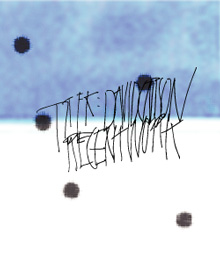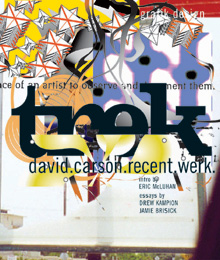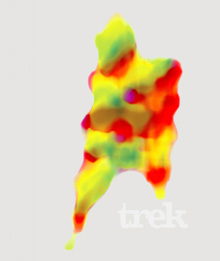
David Carson
November 12, 2003
by Armin Vit
Speak Up: The first question
that comes to mind is an easy one (at least for me), It has been quite some time
since we’ve heard anything from “Camp David,” where have you been
for the past five years? Has it been a conscious decision to stay off the public
eye?
David Carson: Family, traveling,
teaching, making books, designing, having fun. I’m probably an ‘overheated
medium’. You can read about that in
Understanding Media. Once you stop doing a monthly magazine you tend to disappear
a bit from the media end of things. Just all part of the natural cycle. Which
of course is fine. I never expected this thing to get as big as it did, or last
so long, just by doing something I love.
It’s been a crazy 5 years, well actually a crazy decade or so, but no complaints. I think I’m one of the most fortunate designers in the world to get to do what I do. I’ll resist giving you a laundry list (well, semi-resist) of clients over the past few years, but one I’m most excited about is Jim Richardson, over at Union Fonts. I was honored to be asked to design a poster that will help raise money to build 2 orphanages for kids living with AIDS in Africa. That, along with other pro-bono work for children’s art museums in Germany and South Carolina has been some of the most rewarding work. Also being art director and designer for the Marshall McLuhan estate has been a great experience. We’ve got projects lined up well into the next 5 years, working closely with his son Eric and wife Corrine.
SU: It has been more than ten years after you not only challenged but actually changed many of the notions that ruled graphic design for decades and decades, is it hard (or make your work seem futile) that graphic design today is strongly minimal and rigid once again?
DC: It’s all cyclical, everything and anything. Graphic design has been loosening up and getting more expressive and experimental again, especially at the student level.

|
 |
|
I never expected this thing to get as big as it did, or last
so long, just by doing something I love.
|
|

SU: Related to the question
above, at the height of your influence (early to mid 90s) the “deconstructivist”
(to label it somehow) was one of the most apparent trends in graphic design, do
you see any of it still lingering today?
DC: I’ve really never associated
myself with any particular ‘movement,’ and labels in general can be
a bit futile/silly. I never get invited to any of the deconstructionist club meetings,
luncheons, or actually ANY of their social events now that I think about it.
SU: It would be unrealistic to disregard the effect you had on our profession as nothing but a passing fad, you undoubtedly changed the way graphic design is practiced and viewed; after years and years of praise, disdain, insults and honors your contributions to the field have been well documented and cemented as one of the most important, what is your reaction to that?
DC: Well, thank you. It’s
hard to digest it all with any objectivity.

|
I never get invited to any of the deconstructionist club meetings, luncheons, or actually ANY of their social events now that I think about it. |
|
 |
|

SU: In a broad sense, has your
design aesthetic changed at all in recent years? Are your clients still expecting
“Ray Gun David Carson” when they hire you?
DC: The basic approach remains similar: personal, intuitive and extremely self-indulgent. Hopefully it’s continuing to evolve. But Ray Gun was almost a decade ago and I rarely hear it referenced, especially from clients. They do come to me, like I’m sure they do with other designers, because they feel they want something a bit different, or less predictable, or maybe just by accident because they find me in the phone book. And lots of people hate what I do and stay far away.
SU: Many of our profession’s
greats (Bass, Rand, Tibor) are recognized for their work, but also for their personalities
(good or bad). Any designer over forty years has a great story (heart-warming
is a common theme) to tell about any of these iconic designers. Obviously separating
the work from the person is almost impossible. In my opinion you belong among
these elite of designers, but your reputation seems to be, let’s say…“not
good.” Does it worry you that any tale about you from a designer in their
late twenties, early thirties starts or ends (in some cases both) with “what
an asshole”?
DC: Well, you’ve grouped
me with some majorly talented people I’m not sure I belong with, but thank
you. I think the name-calling thing just comes with the territory. It’s just
part of the whole experience. And I wouldn’t trade any of it.
I served on the board of directors with Saul Bass for the Aspen Design Conference and he used to talk to me a lot about what he went through getting started, becoming famous, etc. He had a lot of good advice I’ve tried to heed over the years. He went through a surprising amount of the same stuff I have. I spent some interesting late nights in Tibor’s tiny little hotel room in Venice, Italy, learning (actually NOT learning) how to drink Grappa, and he of course had been through the name-calling and whole bad-boy-label thing and had a ton of great insight. One thing we all agreed on was the people who seem to say the meanest/least truthful things are generally the ones who don’t know you or have never actually met you and/or spent any real time with you.
I don’t think you’d find even one of the hundreds of my workshops attendees
who would agree with that [being an asshole] opinion… And very few of the
thousands of people worldwide who have heard me lecture would agree with that.
I don’t doubt they’re out there -I just don’t hear from them. I’ve
always been shy, and it takes me a while to feel comfortable with new people.
I think sometimes that shyness gets misinterpreted. And then, other times, I’ve
probably just been a real asshole.
But I have no worries AT ALL about the good stories emerging. From times spent looking at individual students work around the world, to helping bring together designers in war torn Serbia, Belgrade, Kosovoe, Bosnia, Slovenia, Tel Aviv, etc. Now I have offers to go to Iran, Afganistan, Pakistan, India, Korea and China and speak with their designers. I had an amazing first experience in Moscow last summer. It’s always the people you remember the most from these journeys, not the physical place. One of my best workshops ever was in Caracas, Venzeuala just last month, with other especially meaningful ones in Ecuador, Mendoza, Argentina, Santiago. Maribor and Villa Julia outside Baltimore.
I rarely get paid anything for the talks and/or workshops, but they are well worth the life experience. Nothing yet from Iraq. I get hundreds of emails from around the world daily, many from the demographic you mention. Some typical ones I’ve included in TREK.

|
 |
|
TREK is my latest self-indulgent tome – my first design
book in over 5 years.
|
|

SU: Can you tell us about TREK?
DC: TREK is my latest self-indulgent
tome – my first design book in over 5 years. It’s my fourth book.
I see these books more like record albums, (actually, CDs I guess). They’re put together at different periods in one’s life, and thus the contents are partly dictated by life events. I think this same concept holds true for many musicians. TREK touches briefly on a lot of subjects, including 9/11, the Iraq war, family, friends, love, loss, relationships, the Probes of Marshall McLuhan, student work, and includes one of the best ads I’ve ever seen Ð so good I made it the back cover. A classic example of how design and advertising can work together to actually do something that matters.
And, yes, there’s a healthy dose of
good ol’ show + tell –
sometimes without the tell.
As always, I see things after printing that I wish I had done differently, and
that’s certainly the case with TREK. But I find these books fun to do, and
the strange thing is you never actually ‘finish’ designing - it just
gets printed at some point during the process…
Inside the book there’s also a few surprises, and 3 excellent essays, with an especially thought-provoking introduction by Eric McLuhan, and one by Drew Kampion, one of my favorite writers. I think the people who like or follow my work will find TREK interesting, and those who don’t will have plenty of new material.
Plus it’s really heavy.
SU: Sticking with the personality
questions – you are no longer the “bad boy” of graphic design and
the hoopla surrounding you is not as strong anymore, what do you think defines
you today?
DC: Dad.

|
 |
|
And, yes, there’s a healthy dose of good ol’ show + tell –
sometimes without the tell.
|
|

SU: Given that the profession is supposedly in a slump, what do you see in graphic design today? Is there anything out there that gets your attention?
DC: I like to see what’s happening in street art, and how that is changing or affecting advertising art.
SU: Looking back, as well as forward, on your career, what do you think is your major contribution to the field?
DC: I opened a few doors, and inspired some folks.
SU: Thanks David.

This interview has been conducted exclusively for Speak Up.
Reproduction without our written consent is strictly prohibited. Please if you would like to use it for educational purposes or if you are interested in other means of reproduction. Thank you for your understanding.





